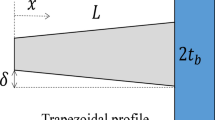Abstract
Although tapered fins transfer more rate of heat per unit volume, they are not found in every practical application because of the difficulty in manufacturing and fabrications. Therefore, there is a scope to modify the geometry of a constant thickness fin in view of the less difficulty in manufacturing and fabrication as well as betterment of heat transfer rate per unit volume of the fin material. For the better utilization of fin material, it is proposed a modified geometry of new fin with a step change in thickness (SF) in the literature. In the present paper, the homotopy perturbation method has been used to evaluate the temperature distribution within the straight radiating fins with a step change in thickness and variable thermal conductivity. The temperature profile has an abrupt change in the temperature gradient where the step change in thickness occurs and thermal conductivity parameter describing the variation of thermal conductivity has an important role on the temperature profile and the heat transfer rate. The optimum geometry which maximizes the heat transfer rate for a given fin volume has been found. The derived condition of optimality gives an open choice to the designer.







Similar content being viewed by others
Abbreviations
- a:
-
Dimensionless cross-sectional area defined in Eq. (27)
- A:
-
General differential operator
- Ac :
-
Cross-sectional area of the fin, m2
- B:
-
Boundary operator
- C1,2,3 :
-
Integral constants
- k:
-
Thermal conductivity W/(mK)
- ℓ:
-
Length of the thin section of the fin, m
- L:
-
Length of the entire fin, m
- N:
-
Nonlinear operator
- Nc :
-
Conduction-radiation parameter
- q:
-
Dimensionless heat transfer rate
- Q:
-
Heat transfer rate per unit fin depth, W/m
- t:
-
Unreduced semi-thickness of the fin, m
- T1 :
-
Temperature within the thin section of the fin, K
- T2 :
-
Temperature within the thick section of the fin, K
- Tb :
-
Base temperature, K
- x:
-
Axial coordinate for entire fin, m
- x1 :
-
Axial coordinate for the thin section of the fin, m
- x2 :
-
Axial coordinate for the thick section of the fin, m
- α:
-
Thickness parameter
- β:
-
Thermal conductivity parameter
- δ:
-
Dimensionless fin semi thickness
- ε:
-
Emissivity of the fin material
- η:
-
Fin efficiency
- κ:
-
A constant for variable thermal conductivity, K−1
- λ:
-
Length ratio
- σ:
-
The Stefan-Boltzmann constant, W/(m2 k4)
- θ:
-
Dimensionless temperature within the thin section of the fin
- ϕ:
-
Dimensionless temperature within the thick section of the fin
- ξ:
-
Dimensionless axial coordinate of the thin section of the fin
- τ:
-
Dimensionless axial coordinate of the thick section of the fin
- ζ:
-
Dimensionless axial coordinate for the entire fin
- ADM:
-
Adomian decomposition method
- HPM:
-
Homotopy perturbation method
- SF:
-
Step fin
References
Chung BTF, Zhang BX (1991) Optimization of radiating fin array including mutual irradiations between radiator elements. ASME J Heat Transf 113:814–822
Krishnaprakas CK, Narayana KB (2003) Heat transfer analysis of mutually irradiating fins. Int J Heat Mass Transf 46:761–769
Naumann RJ (2004) Optimizing the design of space radiators. Int J Thermophys 25:1929–1941
Arslanturk C (2006) Optimum design of space radiators with temperature-dependent thermal conductivity. Appl Therm Eng 26:1149–1157
Hollands KGT, Stedman BA (1992) Optimization of an absorber plate fin having a step change in local thickness. Sol Energy 49:493–495
Aziz A (1994) Optimum design of a rectangular fin with a step change in cross-sectional area. Int Commun Heat Mass Transf 21:389–401
Kundu B, Das PK (2001) Performance analysis and optimization of annular fin with a step change in thickness. J Heat Transf 123:601–604
Malekzadeh P, Rahideh H, Karami G (2006) Optimization of convective-radiative fins by using differential quadrature method. Energy Convers Manag 47:1505–1514
Kundu B (2009) Analysis of thermal performance and optimization of concentric circular fins under dehumidifying conditions. Int J Heat Mass Transf 52:2646–2659
He JH (1999) Homotopy perturbation technique. Comput Methods Appl Mech Eng 178:257–262
He JH (2000) A coupling method of a homotopy technique and a perturbation technique for non-linear problems. Int J Non Linear Mech 35:37–43 V
He JH (2003) Homotopy perturbation method: a new nonlinear analytical technique. Appl Math Comput 135:73–79
Saadatmandi A, Dehghan M, Eftekhari A (2009) Application of He’s homotopy perturbation method for nonlinear system of second-order boundary value problems. Nonlinear Anal Real World Appl 10:1912–1922
Öziş T, Ağırseven D (2008) He’s homotopy perturbation method for solving heat-like and wave-like equations with variable coefficients. Phys Lett A 372:5944–5950
Cowdhury MSH, Hashim I (2008) Analytical solutions to heat transfer equations by homotopy-perturbation method revisited. Phys Lett A 372:1240–1243
Cowdhury MSH, Hashim I, Abdulaziz O (2009) Comparison of homotopy analysis method and homotopy-perturbation method for purely nonlinear fin-type problems. Commun Nonlinear Sci Numer Simul 14:371–378
Ascher U, Petzold L (1998) Computer methods for ordinary differential equations and differential-algebraic equations. SIAM, Philadelphia
Incropera FP, DeWitt DP (1993) Introduction to heat transfer, 3rd edn. Wiley, New York
Author information
Authors and Affiliations
Corresponding author
Rights and permissions
About this article
Cite this article
Arslanturk, C. Performance analysis and optimization of radiating fins with a step change in thickness and variable thermal conductivity by homotopy perturbation method. Heat Mass Transfer 47, 131–138 (2011). https://doi.org/10.1007/s00231-010-0673-8
Received:
Accepted:
Published:
Issue Date:
DOI: https://doi.org/10.1007/s00231-010-0673-8



